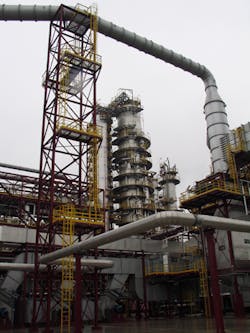Gasoline Producer Achieves All ROI Targets
The PKN Orlen refinery in Plock, Poland, is one of the largest refineries and gasoline producers in Europe. Other Orlen products include diesel oil, furnace oil, aviation fuel, plastics and petrochemicals.
To modernize and expand gasoline production in 1987, PKN Orlen selected ABB, a global supplier of automation and power technologies based in Zurich, to design, procure, install and commission a high capacity gasoline blender. In addition to field equipment, the distributed control system (DCS) and instrumentation, the scope of supply also included Regulatory Blend Control (RBC) and Advanced Blending Control (ABC) software solutions. The blender plant was revamped again in 2003 to include additional blend component lines, equipment and a control system upgrade to allow further expansion in the refinery capacity.
ABC is a Microsoft Windows-based software solution from ABB that provides complete blend operation management. The planner or operator can create a blend order for a given batch volume, product grade and product tank. The component tanks and field equipment line-ups can be automatically selected by ABC and the blend order optimized to produce the least expensive blend within the constraints imposed by the planner, tank inventories and equipment capacity. The blend order can be downloaded to RBC.
“We trained our people on the ABC server so that we can make any future modification ourselves—adding tanks, components, product grades and lineups, for example, without vendor assistance,” said Waldemar Nagórko, head of Orlen’s automation department.
OPC blends communications
The RBC, which controls regulatory blend, runs in the ABB Industrial IT control system at Orlen. It performs lineup, startup, monitoring and shutdown operations. ABC interacts with RBC through an OPC server. During blending, ABC monitors active plant data and constraints, and uses feedback from the header analyzer to correct and continuously download optimized recipes to RBC to produce a “blend-on-specification” without property violation or giveaway.
The open architecture of the system also allows interfacing to other plant systems, including the laboratory information and tank information management systems for data collection and analysis, as well as the plant’s strategic and operational planning systems.
“It’s very easy to extend the ABB system. Even if we’re doing a big step-change, we (seldom) have to replace hardware, which doesn’t happen with other vendors,” says Nagórko. “Industrial IT speeds up decision making for our management and enables us to prepare advanced and optimization software. This is a good example of step evolution from a very, very traditional control system up to a very advanced one.
“We achieved all our targets with our ABB control system upgrade. The most important targets were: optimal use of more components, optimized costs, elimination of re-blends, very good prediction and control of more product properties, reduced production costs and reduced property giveaways,” adds Nagórko. Giving away property (i.e., octane that is higher than required minimum specification) increases the cost of blend by consuming more expensive blend components. Re-blending to remove violation of product specification or to reduce property giveaway typically means higher production costs and reduced profit.
For more information on ABB’s Industrial IT System, call 1.800.922.2475 (585.273.6417, outside of the U.S.) or visit www.abb.com/controlsystems.

